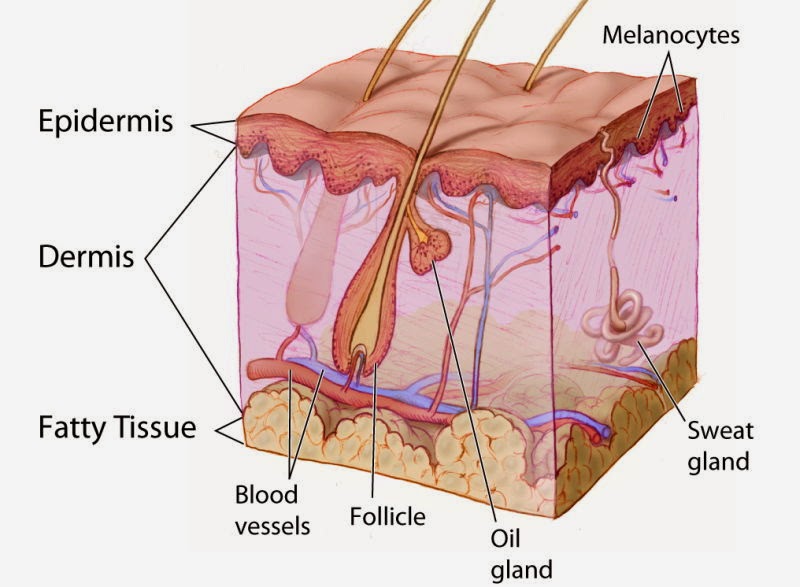Down below are some quick notes over the layers of skin and below that is a write-up over an example of what a burn does to your skin. Enjoy.
- Epidermis
- composed of keratinized stratified squamous epithelium, consisting of 4 distinct cell types and 4 oor 5 layers
- cell types include keratinocytes, melanocytes, merkel cells, and langerhans cells
- outer portion of the skin is exposed to the external environment and functions in protection
- Layer:
- stratum basal
- stratum spinosum
- stratum granulosum
- stratum lucidum
- stratum corneum
- Dermis
- 2nd major skin region
- cell types
- fibroblasts
- macrophages
- mast cells
- white blood cells
- layers:
- papillary layer
- reticular layer
- Hypodermis
- subcutaneous layer deep to the skin
- composed of adipose and areolar connective tissue
The skin consists of three major regions: epidermis, dermis, and hypodermis. Our skin is the first line of defense against pathogens and preventing loss of fluids. When you get burned, the burn is prone to infection. Severe burns can cause you to become dehydrated due because you burn through all your layers and through all your veins. The layer that functions as waterproofing is the stratum corneum layer.
There are three types of burns. The first burn I'll talk about it first-degree burn. First- degree burn is when the epidermis layer is the only one damaged. When you have a first-degree burn, you'll have redness, swelling, or pain. An example of a first-degree burn is a sunburn or touching a hot or cold object and takes about a week to heal. The next burn is second-degree burn. This burn damages the epidermis and the top layer of the dermis. The symptoms of second-degree burn mimic first-degree but also blisters appear. The time it takes for these burns to heal depends upon how deep in the dermis the burn is. The third burn is called third-degree burn. This is when the entire thickness of the skin is damaged. Symptoms are the burn appears black, cherry red, or grey-white and there will be no pain due to the nerves being burned. Your skin usually prevents fluid loss but when you have a severe burn, it increases by a great amount. Since your body is losing lots of fluids, you have to replace them at the same rate you're losing them.
There is a way to measure burns, it's called the "rules of nine". This rule estimates the severity of burns. A burn is considered critical if over 25% of the body has second-degree burn, over 20% of the body has third-degree burn, or if there are third-degree burns on the feet, hands, or face. Down below is a link to a website I collected some information from to help me write this post and also I used information off of my teachers powerpoint.
















